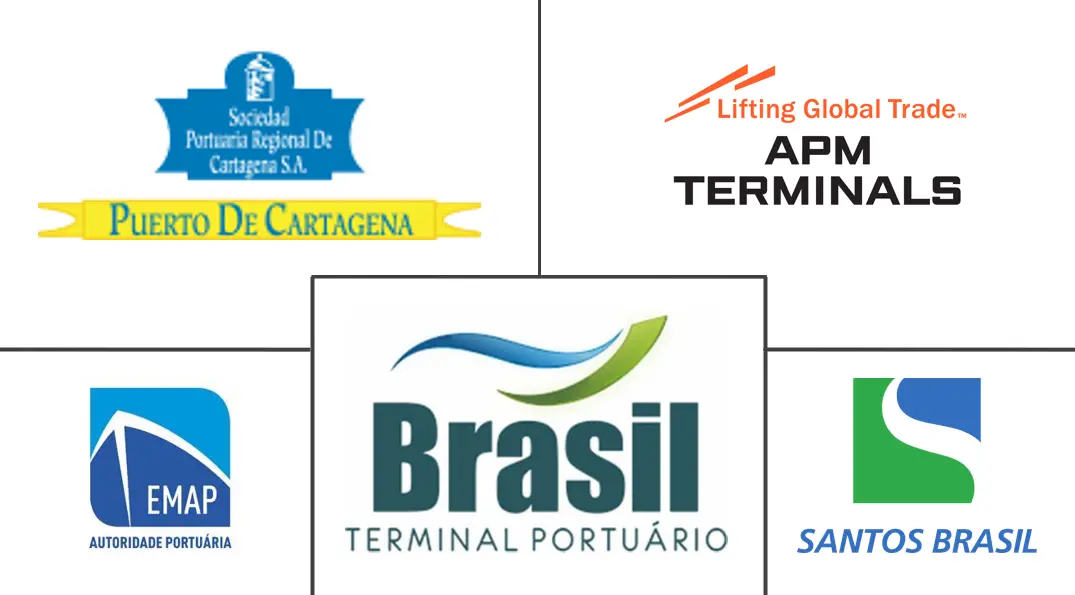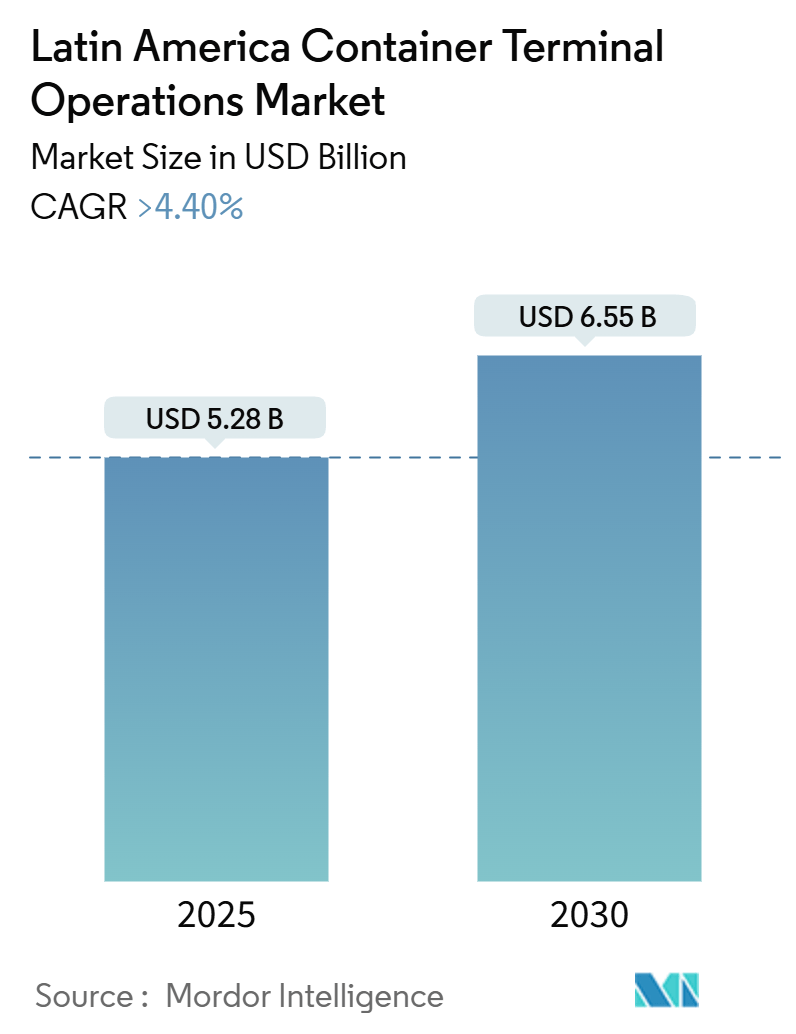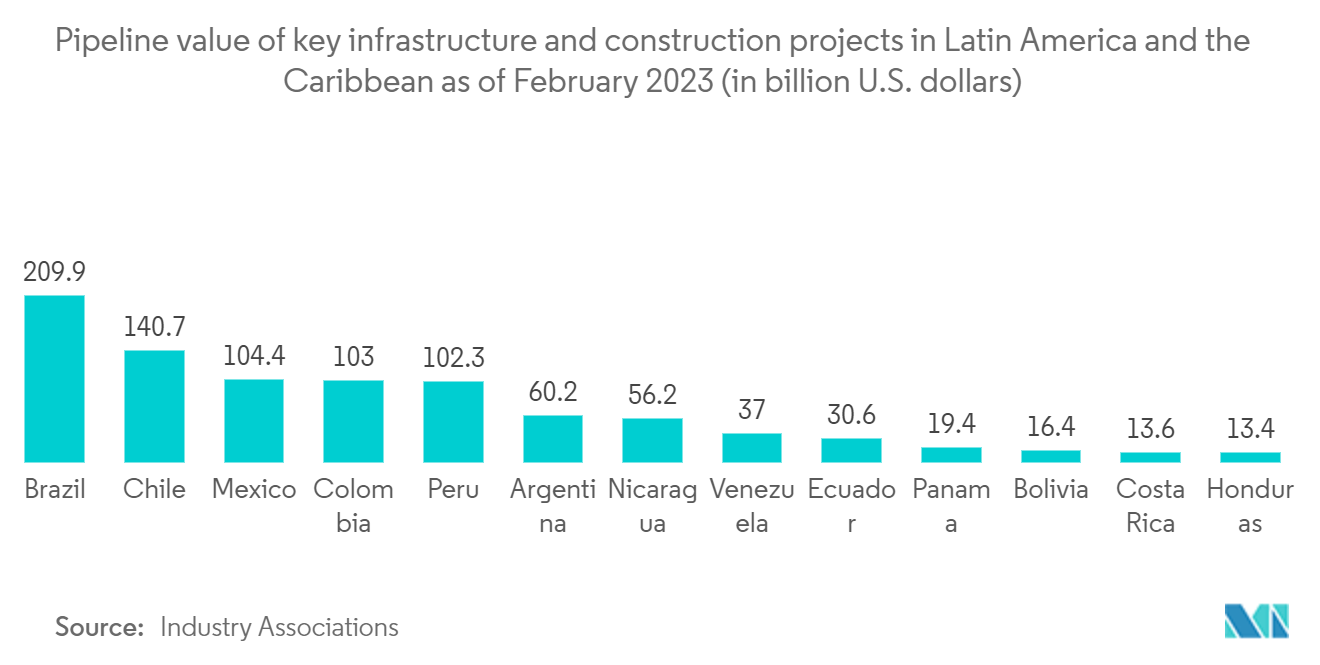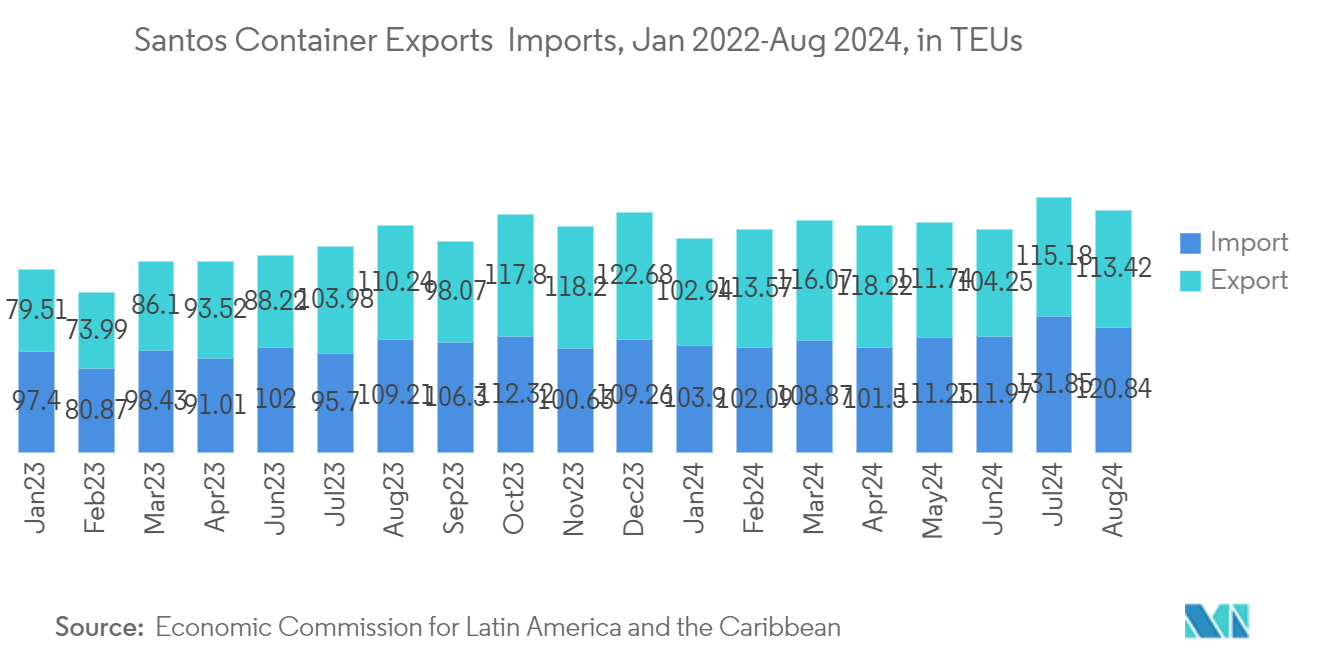Latin America Container Terminal Operations Market Analysis
The Latin America Container Terminal Operations Market size is estimated at USD 5.28 billion in 2025, and is expected to reach USD 6.55 billion by 2030, at a CAGR of greater than 4.40% during the forecast period (2025-2030).
Latin America accounts for roughly 7% of global trade, heavily featuring raw materials, both mineral and vegetable, alongside a diverse range of foodstuffs. The region's international trade is intricately linked to the world's three primary maritime routes: Europe, North America, and Asia, with Asia's involvement on the rise. However, trade within the region itself is on the decline.
During the same timeframe, capacity serving Latin America – largely insulated from the Red Sea crisis – surged by 17.4%, reaching a total of 4.1 million TEUs across all trades. Notably, carriers like CMA CGM, Hapag-Lloyd, and Cosco have recently acquired neo-Panamax ships, each with a capacity of 13,250-14,100 TEUs. These vessels, tailored for Latin American trade with enhanced reefer capacities, have been named after South American regions and cities. This influx has elevated the fleet servicing Latin America to 4.1 million TEUs, marking a million TEU increase from two years prior,” the analysts noted.
They further highlighted that a predominant portion of the capacity now allocated to Latin America originates from Asia. Specifically, around 1.53 million TEUs are dedicated to services on the west coast of South America, while 860,000 TEUs cater to the east coast.
Data from CTS in 2024 indicates that shipments from Asia to Latin America in April saw a 5.2% uptick, nearing 423,000 TEUs. Approximately 50 vessels servicing the Asia-Latin America west coast fall within the 12,500-17,999 TEU range, accounting for 47% of the route's total capacity.
Due to a surge in Chinese exports and heightened demand for cargo space, container shipping rates between China and Latin America have seen a notable spike, leading shippers to expand their capacity on this route.
As reported by the Shanghai Shipping Exchange, shipping rates from China to South America's East Coast soared to USD 7,065 per standard container in May 2024, marking a staggering 153.41% jump since late March.
Major global shipping players, such as Mediterranean Shipping Company S.A. and China COSCO Shipping Co. Ltd., have intensified their operations between China and Mexico. Additionally, CMA CGM, a French container shipping firm, has inaugurated a fresh route from China to Mexico, deploying eight vessels, each boasting a capacity of over 4,000 standard containers.
In the initial four months of 2024, Latin America stood out as the prime destination for Chinese exports, witnessing an 11.4% year-over-year growth, predominantly fueled by Mexico and Brazil. China's export value to Mexico surged by 15.1%, reaching 198.3 billion yuan (USD 27.3 billion) – over a third of the region's total exports.
Chinese exports to Latin America are led by electrical machinery, equipment, and parts, trailed by nuclear reactors, boilers, and various machinery and mechanical appliances.
In conclusion, Latin America's trade dynamics are evolving, with significant growth in capacity and exports, particularly from Asia. The region's strategic importance in global trade is underscored by the increasing deployment of large-capacity vessels and the surge in shipping rates.
As Chinese exports to Latin America continue to rise, driven by demand in countries like Mexico and Brazil, the region is poised to play a crucial role in the global supply chain. However, the decline in intra-regional trade remains a challenge that needs to be addressed to ensure balanced and sustainable growth.
Latin America Container Terminal Operations Market Trends
Rise dry cargo shipping dominating the market
Dry cargo, encompassing a diverse array of merchandise and industrial products, plays a pivotal role in Latin America's trade volume. The region's strategic positioning, linking it to major global markets, not only facilitates the movement of these goods but also amplifies the demand for container terminal operations focused on dry cargo.
Fueled by growth in its industrial and agricultural sectors, Latin America has witnessed a surge in the demand for containerized transportation of dry goods. Regional ports are vital for exporting key commodities such as soybeans, sugar, and machinery, predominantly classified as dry cargo. Dominating the scene, the Port of Santos, South America's largest port, boasts robust infrastructure tailored for high dry cargo volumes.
Annually processing over 90 million tons, a significant chunk of which is dry bulk, the port's multiple terminals and expansive storage capacities ensure efficient handling. Leveraging advanced equipment, the port enhances operational efficiency, utilizing conveyor systems, grain-receiving hoppers, and ship loaders for grains and fertilizers, all equipped with modern safety and environmental controls.
In March 2024, Inchcape proudly inaugurated its new office in Salaverry, Peru. This strategic move bolsters Inchcape's ability to cater to the region, especially the dry bulk terminals, cementing its role as a key player in Peru's burgeoning maritime sector, with a focus on bulk cargo, projects, and liquids.
A 40% uptick in Argentina's grain exports for 2024, rebounding from last year's drought, albeit still trailing the 2019-2022 average. As conditions remain favorable for maize and soybean crops, maize is set to lead the surge with a projected 71% increase, translating to an extra 17 million tonnes. Handling 22% of Peru's exports, the port of Salaverry primarily deals with coal, copper concentrate, and ethanol. With iron ore set to join the lineup, Inchcape's new branch will adeptly represent clients in both coal and iron ore shipments.
In July 2024, Hapag-Lloyd announced a General Rate Increase (GRI) for shipments from East Coast ports of Latin America to North America, Central America, and the Caribbean. Effective from August 2024, the GRI of USD 300 per container applies to both dry and reefer boxes and remains in effect until further notice.
Hapag-Lloyd clarified that Latin America's East Coast encompasses ports in Brazil, Argentina, Uruguay, and Paraguay, while its North American counterparts include the U.S., Canada, and Mexico. With rising trade volumes, strategic port investments, and tech advancements, dry cargo has firmly established itself as the dominant segment in Latin America's Container Terminal Operations Market.
In conclusion, the dry cargo segment in Latin America is poised for continued growth, driven by strategic geographic advantages, robust port infrastructure, and technological advancements. The region's ports, particularly the Port of Santos and Salaverry, play a critical role in facilitating this growth.
Companies like Inchcape and Hapag-Lloyd are making significant investments to enhance their operational capabilities and meet the increasing demand. As the market evolves, stakeholders must continue to innovate and invest in infrastructure to maintain the momentum and capitalize on emerging opportunities in the dry cargo sector.
Brazil dominating the container terminal market
According to a recent report by the National Waterborne Transport Agency (ANTAQ), Brazil's port market experienced a robust growth of 5.2% in Q1 2024. This growth was largely driven by an uptick in containerized cargo and solid bulk operations. In the first quarter of 2024, Brazilian ports handled 302.9 million tonnes of cargo, up from 287.9 million tonnes in the same quarter of 2023.
Notable surges were seen in iron ore transportation, which rose by 13.95%, and sugar, which skyrocketed by 83.08%. The quarterly throughput reached 34.1 million tonnes, marking a year-on-year increase of 20.3%, translating to 3.1 million TEUs. Of this, 23.2 million tonnes were transported via long-haul journeys, and 10.5 million tonnes were moved through cabotage.
Solid bulk cargo, making up 57.7% of the total throughput, grew by 6.43% year-on-year, totaling 174.6 million tonnes from January to March 2024. In contrast, liquid bulk and general cargo saw slight declines, with liquid bulk moving 79.9 million tonnes (down 0.46%) and general cargo at 14.3 million tonnes (down 6.4%).
Long-haul cargo for Q1 2024 reached 210.1 million tonnes, up 7.32% from the previous year. Cabotage cargo also increased by 2.98%, totaling 72.7 million tonnes, with container cabotage seeing a notable 25.06% rise compared to Q1 2023.
Additionally, port and maritime support cargo operations grew by 9.74%, totaling 0.4 million tonnes. Conversely, inland navigation saw a 7.47% decline, moving 19.2 million tonnes. In 2023, the Paranaguá Container Terminal (TCP) set a record by handling 1,253,397 TEUs, marking a 7.93% increase from 2022's record.
TCP, with 19 weekly calls in Brazil, achieved its highest monthly vessel berthing in December, accommodating 83 vessels, surpassing October 2023's record of 77. November 2023 was notable for two records at the terminal's nine gates: 49,517 containers passed through, with a daily peak of 2,345, breaking previous monthly highs.
October 2023 saw refrigerated container operations reach 11,487, up 6.79% from June's peak. Given the prominence of refrigerated container operations at TCP, we've expanded our reefer yard outlets by 45%, from 3,624 to 5,268, making TCP South America's largest refrigerated container yard. The terminal's main export, animal protein, rose by 19% from 2022, totaling 235,898 TEUs, which included frozen chicken (181,878), beef (37,169), and pork (14,369).
Sugar exports were particularly striking, jumping 12,667% from 45 TEUs in 2022 to 5,745 TEUs in 2023. On the import side, TCP received shipments primarily of chemicals (43,756), machinery and mechanical components (34,081), and plastics (31,489). Brazil's busiest container terminals include the Port of Santos, Paranagua, and Rio Grande, all of which handle significant volumes of import, export, and cabotage cargo.
In conclusion, the Brazilian port market has shown remarkable resilience and growth, driven by increased containerized and solid bulk cargo operations. The significant rise in throughput and record-breaking performances at key terminals like TCP highlight the sector's robust expansion. Despite minor declines in liquid bulk and general cargo, the overall positive trends underscore the market's potential for continued growth and development.
Latin America Container Terminal Operations Industry Overview
The Market is relatively fragmented, with many local and International players like Brasil Terminal Portuário S.A., Santos Brasil Participacoes S/A, Maranhense Port Administration Company (EMAP)., APM Terminals Callao, The Port of Cartagena Organization. The Market is expected to show positive growth in the forecast period as many companies are jumping into the Market.
The private port operators have significantly improved the efficiency and productivity of cargo management, making LAC more competitive. Especially in Latin American and Caribbean ports, operational efficiency has increased by more than 20% since the turn of the 20th century. Data show that private sector engagement and port competition correlate with higher operational and economic performance and better-maintained ports.
Latin America Container Terminal Operations Market Leaders
-
Brasil Terminal Portuário S.A.
-
Santos Brasil Participacoes S/A
-
Maranhense Port Administration Company (EMAP).
-
APM Terminals Callao
-
The Port of Cartagena Organization
- *Disclaimer: Major Players sorted in no particular order
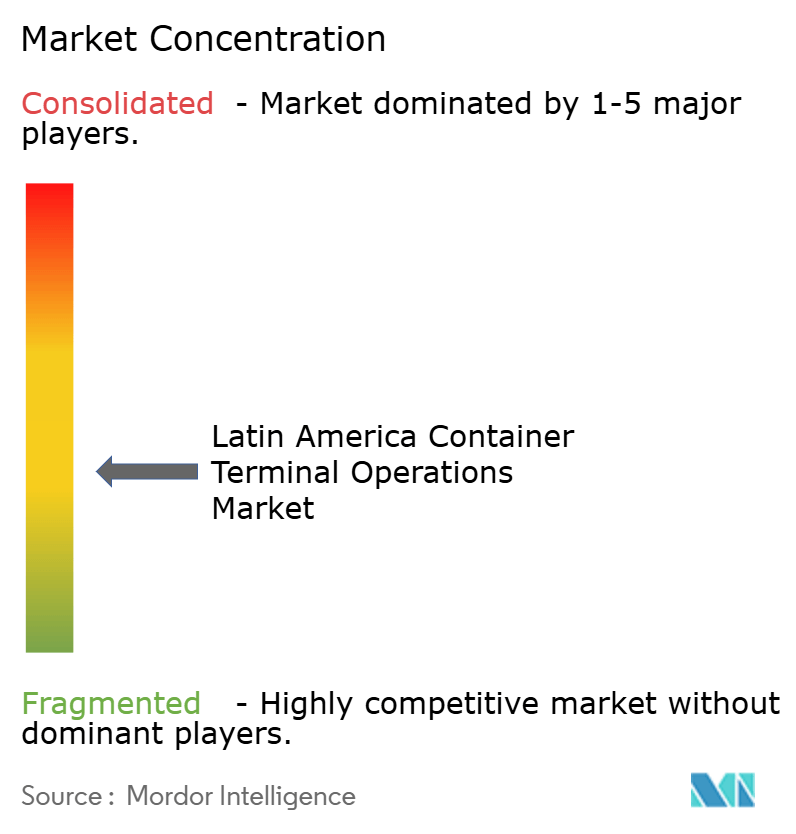
Latin America Container Terminal Operations Market News
- October 2024: The Brazilian government is advancing with plans to offer a leasing contract that will result in the expansion of the STS10 container terminal at the country's largest port, Santos in São Paulo state.
- May 2024: Terminales y Servicios S.A. has embarked on constructing a new agro-industrial port in Timbúes, located in the Santa Fe province of Argentina. The project, with an estimated investment of around USD 550 million, kicked off at the end of March 2024. The company envisions this port solidifying the region's status as "one of the largest agro-industrial export hubs in the world." The substantial investment covers the construction of quays, storage silos, and related infrastructure. Once operational, the port is set to manage fertilizer shipments, grains, and other value-added by-products.
Latin America Container Terminal Operations Industry Segmentation
Container Terminal Operation and Cargo Handling Container terminals are designated for the handling, storage, and possibly loading or unloading of cargo into or out of containers, and where containers can be picked up, dropped off, maintained, stored, or loaded or unloaded from one mode of transport to another (that is, vessel, truck, barge, or rail). A container terminal's main activity is transferring cargo units from one transport modality to another.
A complete background analysis of the Latin America Container Terminal Operations market, which includes an assessment of the economy, market overview, market size estimation for key segments, emerging trends in the market, market dynamics, and key company profiles, are covered in the report. The impact of COVID-19 has also been incorporated and considered during the study.
The Latin America container terminal operations market is segmented by service (stevedoring, cargo handling & transportation, and others), by cargo type (dry cargo, crude oil, and other liquid cargo) and by country(Brazil, Argentina, Peru and Rest of Latin America). The report offers market size and forecasts for the Latin America container terminal operations market in value (USD) for all the above segments.
| By Service | Stevedoring |
| Cargo Handling & Transportation | |
| Others | |
| By Cargo Type | Crude Oil |
| Dry Cargo | |
| Other Liquid Cargo | |
| By Country | Brazil |
| Argentina | |
| Peru | |
| Rest of Latin America |
Latin America Container Terminal Operations Market Research FAQs
How big is the Latin America Container Terminal Operations Market?
The Latin America Container Terminal Operations Market size is expected to reach USD 5.28 billion in 2025 and grow at a CAGR of greater than 4.40% to reach USD 6.55 billion by 2030.
What is the current Latin America Container Terminal Operations Market size?
In 2025, the Latin America Container Terminal Operations Market size is expected to reach USD 5.28 billion.
Who are the key players in Latin America Container Terminal Operations Market?
Brasil Terminal Portuário S.A., Santos Brasil Participacoes S/A, Maranhense Port Administration Company (EMAP)., APM Terminals Callao and The Port of Cartagena Organization are the major companies operating in the Latin America Container Terminal Operations Market.
What years does this Latin America Container Terminal Operations Market cover, and what was the market size in 2024?
In 2024, the Latin America Container Terminal Operations Market size was estimated at USD 5.05 billion. The report covers the Latin America Container Terminal Operations Market historical market size for years: 2019, 2020, 2021, 2022, 2023 and 2024. The report also forecasts the Latin America Container Terminal Operations Market size for years: 2025, 2026, 2027, 2028, 2029 and 2030.
Our Best Selling Reports
Latin America Container Terminal Operations Industry Report
Statistics for the 2025 Latin America Container Terminal Operations market share, size and revenue growth rate, created by Mordor Intelligence™ Industry Reports. Latin America Container Terminal Operations analysis includes a market forecast outlook for 2025 to 2030 and historical overview. Get a sample of this industry analysis as a free report PDF download.

